
Change the words...arrange the words . . .
Books written and illustrated by Loris Lesynski
Loris Lesynski
Profile by Dave Jenkinson.
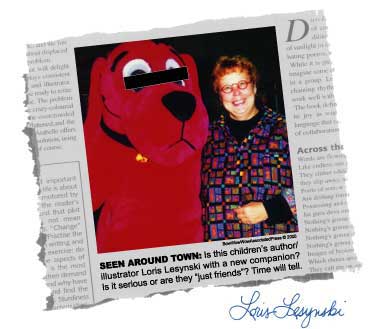 "I knew this interview was coming, so I've been mulling it over. I figured you'd ask me what I was working on, and I thought I'd talk to you about my intention to write a middle reader comic
novel. I was sure this is what I was planning, that's what I've been telling people, but talking to you in my head, I realized it isn't what I want to do at all! No wonder it's not happening. I just thought I was stuck, or bone idle. I started thinking about the books I've really admired. When I first read Bernice Thurman Hunter's That Scatterbrain Booky, I couldn't believe how good it was, how much it made me feel. It's about a girl with all kinds of difficulties, yet she's still positive and good-natured. Sarah Ellis's A Prairie as Wide as the Sea also has much family strife in it, but Ivy has a spunky, joyful quality to her. I think that's what I really want to do, write about a character who's okay - better than okay - even though home life is sometimes dreadful. I think those are both terrific books, for readers of any age."
"I knew this interview was coming, so I've been mulling it over. I figured you'd ask me what I was working on, and I thought I'd talk to you about my intention to write a middle reader comic
novel. I was sure this is what I was planning, that's what I've been telling people, but talking to you in my head, I realized it isn't what I want to do at all! No wonder it's not happening. I just thought I was stuck, or bone idle. I started thinking about the books I've really admired. When I first read Bernice Thurman Hunter's That Scatterbrain Booky, I couldn't believe how good it was, how much it made me feel. It's about a girl with all kinds of difficulties, yet she's still positive and good-natured. Sarah Ellis's A Prairie as Wide as the Sea also has much family strife in it, but Ivy has a spunky, joyful quality to her. I think that's what I really want to do, write about a character who's okay - better than okay - even though home life is sometimes dreadful. I think those are both terrific books, for readers of any age."
Loris's author friends have all told her a novel is very, very, very difficult to write; nevertheless,
she still has it on her things-to-do list. "It's a wonderful genre, novels for this age group. But now I know I want to write about dilemmas! pain! suffering! a kid who brilliantly overcomes a family situation! (with humour interwoven of course). I'd probably bought into that falsehood that
writing "just' funny would be easier. I'm always searching for an easier way to do things. Foiled again."
"I'd really like to incorporate into a story the whole issue of how not to take your parents too personally, I suppose because that's been a big issue of my life. Unhappy parents can say things to you, make judgments or offer criticisms that aren't the least bit true. The novel, the one I'm now dedicated to writing (starting five minutes ago) would have to have humorous overtones but some of my own truthful experience, too. It'll probably hurt. I'll probably postpone it a bit longer."
Loris was born in Eskilstuna, a town outside of Stockholm, Sweden on March 16 of an undisclosed year. "My mother and father had each gone there after World War II, quite afraid of the Russians in their home countries of Finland and Poland. They met and married, and when I was two and my sister Lena (pronounced LEN-na) just a baby, we came to Canada. My parents had a very difficult time here. The war experiences had been devastating for both of them - so much so that we never talked about it. They had very little money, it was horribly difficult to find places that rented to people with children, and they weren't at all suited to one another. My father was such a critical and short-tempered man, he might not have been comfortable in any country, with any wife or kids.
The family moved to downtown Toronto. "The years that followed were pretty turbulent financially and emotionally. My father worked as a toolmaker, but didn't like it much and
didn't get along well with the other men. My mother worked as a nurse, often a night nurse. Many times my sister and I woke up in the morning to no one home and came back at noon to the lunch my mother had set out between the time she came home from the hospital and went to sleep."
"Actually, my mother had been in Toronto before. When she was 18, she won a lottery and used the money to come from Finland to Canada. She worked as a maid in Forest Hill for 10 years and told hysterically funny stories about it, the pies that couldn't be cut with an axe, sitting motionless in front of an oven waiting for something to cook. She attended Ontario Bible College, which greatly improved her English. At 28, she visited a friend in the hospital and was so impressed with the nurses in white "dashing up and down the halls, so efficient and professional,' she decided to become a nurse herself and went to Sweden to do her training. Then World War II broke out. Because she was older than the other women, my mother was put in charge. This wasn't the type of person she was at all, so it was quite traumatic for her. She was a sweet person, but not decisive or a disciplinarian."
"My father was from Poland, and had, I believe, been orphaned at an early age and then had a period in a Siberian prison camp at 17. My parents spoke enough Swedish to get along enough to get married. But "getting along' was not something they ever did. I hated it, growing up, and I was pretty angry at them for creating this kind of home, but I bet this goes on in a lot of immigrant families, the kids quickly becoming acclimatized to the new culture, then one of the parents doing so better than the other, a father with old-country ideas of family control."
How did Loris handle this as a child? "I did what most kids do with parents: I ignored them as much as I could, and got on with my own life. I can see why I turned to books so much. I loved writing, drawing, reading. As well, I was good at school and enjoyed it a lot. I sure didn't love going home; I remember approaching the house with slower and slower footsteps every afternoon. I wonder if I can write about that..."
"One of the houses that I grew up in is down in the Beach area of Toronto. I often drive past it,
this little ratty house I remember so well. My sister and I put our footprints in the wet cement of the pathway my father made in the tiny back yard. You can still just see the impressions if you sneak into the yard, which I did one day. The current tenant was not too happy about that."
"From early on, I wanted to be a writer. My second-grade teacher had sent me several times to read out loud to the principal, both Dick and Jane and my own simple stories. I thought this was very strange, but if he needed a story, he needed a story. Then they decided to skip me ahead. It's not that I was so brilliant; in those days, they accelerated kids all the time, especially ones good at reading. I remember I was in the middle of doing a big chalk mural on the blackboard at the back of the room, a cat arched in mid-screech on a fence by moonlight, when the principal of Duke of Connaught School, Mr. Manders (the one who needed frequent stories), came to the doorway, the size of a refrigerator in a grey suit, and said, "Loris, get your crayons.' Out in the hallway he said, "Congratulations. This afternoon, you're going into grade three.'"
"After lunch at home, I returned to school and went into a completely different classroom. The kids were not only all strangers, not only all older and taller than me, but also dressed as monsters, ghosts and witches. Guess on which day of the year they'd chosen to accelerate me? Halloween!"
"I liked grade three, but I never really caught up on the adding and subtracting we would have focused on later in grade two. I still sometimes count with my fingers. In a way, I would have been better off if it hadn't happened, because I really needed stability at school, and skipping was pretty disruptive. But then I think of the wonderful friends I made later in junior high and high school, kids who were in the same grade as I now was, and how I would have missed them if I'd hadn't been moved ahead."
"My parents both had strong artistic abilities; both of them had painted in oils at some point in their lives; my mother used to send illustrated letters home to Finland to her own mother; and they bought us children's records of the lives and music of composers like Mozart and Bach. I played
these bright red records over and over again on our portable record player. They also sent both my sister and me for piano lessons."
"Late one afternoon, when Lena was in with the piano teacher on Hambly Avenue and I was hanging around the neighbourhood waiting for my turn, who did I run into on the street but my third grade teacher, whom I'd just seen in school an hour earlier! (Lena and I took streetcars by ourselves from an early age and explored the downtown streets quite freely.) She invited me back to her house for tea and Peak Freans with her and her husband. It was the first time I'd been in a teacher's house. It was the first time I'd had Peak Freans. Both memorable experiences. This became a regular weekly visit. After my family moved from that neighbourhood, Mrs. Parens and I exchanged letters until I was in high school."
"I'm also still friends with my eighth grade teacher who had a huge influence on me around classical music and poetry. She wrote wonderful poetry herself. When I got older and became a graphic designer, I put together some "chap books' of her work."
"When there's a lot of anxiety and tension at home, I can't think of a better coping technique for a kid than finding a few warm, kind, smart adults out in the world as allies."
Loris's parents [finally!] split up when she was 16. She was then estranged, by her own choice, from her father for 25 years. "Then I decided to contact him again, to find out if we could make some kind of connection. We'd seen him as an enraged tyrant inclined to some violence; he didn't share this view at all and wasn't the least bit remorseful about his behaviour. He still saw everything in terms of his own feelings, what he'd been deprived of, how badly he'd been treated by life, by Canada, by his family. We changed the subject; he congratulated me on the children's books I was now writing and illustrating, and he recalled how many public speaking competitions I'd been part of it in junior high. In his still heavily-accented English, he said to me, "You think you're really good with words, don't you?'
"Well, yes,' I replied, "I guess I do.'
He said, "The thing you don't know about me is that I was also really good with words in my home language.' This had never occurred to me, that in Polish he might be articulate, clear, not just rageful. He said, "When the family was together, by the time I grasped what we were talking about and was able to put it into English, the three of you had already moved on to another topic.' At which point he'd hit one of us or turn over the kitchen table. Not appropriate behaviour, to be sure, and pretty frightening to a child, but I could understand something about how it felt to be crippled in your ability to join a conversation with your family."
"I found that after this I was able to treat him with more compassion and some respect. I read once that what forgiveness means is giving up actively blaming, and that's what I wanted to do. Boy, though, the burden of a parent's voice in one's head - it's pretty immovable."
"Perhaps at some level I understood about the immense importance of language earlier. I've always seen encouraging children's ability to express themselves out loud as essential. My presentations to kids include a lot of "echo reading.' For example, I'll say out loud, from
Dirty Dog Boogie, "I [bold]HAD[bold] a dirty dog,' and the whole room responds with "I
[bold]HAD[bold] a dirty dog' with the same inflection. Lots of expression. Heaps of hamming it up. It's a great technique - the children have a chance to recite aloud without being responsible for content, without being the centre of attention or making mistakes. There's implicit permission to play with words and sound. It's very successful, and very easy to do because of our innate desire to speak, sing, chant together. In modern society we rarely do so. People leap at the chance - I've had rooms of businessmen and rooms of teachers doing it just as eagerly as kids."
Loris is always receiving compliments on her handwriting and can do many different styles of
lettering and penmanship. "That's because," she says, "when I was little, there were workbooks for children in which to practise their writing, and my mother had me do the exercises over and over again while I chatted to her (apparently non-stop - so her version goes) - dozens and dozens of ovals in a row, forwards, then backwards, swirling, flattened. The result is that I have quite good hand control. I can even imitate other people's handwriting. I would have made a good forger."
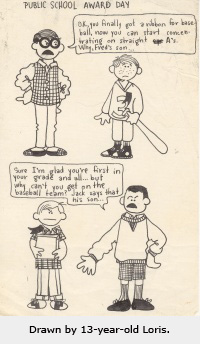
Being able to draw, make posters and do decent lettering are all very useful qualities to have when
going through school. "In those days in junior high, kids had masonite clipboards. I would draw and colour cartoons of the other kids on the backs of them. Oh sure, being rich, good-looking or athletic might have been nice, but being able to draw was also very useful. People like people who can draw. You don't even have to be able to draw that well. My friends also enjoyed the sarcastically-labelled cartoons I did of our teachers."
According to Loris, her high school years did little to encourage her writing and art. "Our art classes in high school were horrible. We had the cheapest materials - newsprint with the wood chips still in it, black ink that came out brown. High school wasn't about creativity - it was Latin! math! history! French! But I did become yearbook editor and had the key to a little storage room designated as the yearbook office; I spent a lot of time in there, reading, writing, drawing, talking with friends. Nobody seemed to notice. Later I learned that the guidance counselor had told all the teachers to go easy on my sister and me at the time my parents separated, so we were allowed a lot of leeway. (It was much rarer in those days for parents to break up.) I also fell in love with graphic design while I was doing the yearbook."
"I finished grade thirteen with good marks except for 15 in calculus (and this was with really trying!) so I had to spend the year after high school in a remedial evening calculus class. I also had to get some money together for university. I found a job typesetting at the local newspaper because I could type so well."
"When I was 10 and thinking ahead to being a novelist, I knew writers had to be able to type so I took a job delivering the morning newspaper. This meant getting up long before dawn, folding
papers in the laundromat, and tromping through huge snowdrifts all winter, but I earned enough to buy a used typewriter and an instruction book on proper typing technique. I'd practise typing all day and also did about half an hour in my mind every night before I fell asleep, and I became
very fast. (At one point later on, I clocked in at 140 words per minute on a typing test. The typing table had moved a couple of inches from the enthusiastic pounding!)"
"At the newspaper, they moved me up to Editorial, and I had my own desk, phone and a huge old-fashioned camera. Very cool. I was writing stories, doing interviews, and drawing spot illustrations. In the evening class, I finally passed calculus (I can't imagine how, since I don't believe calculus exists), received my high school graduation certificate, and had just enough money to attend the University of Toronto for a year. I was disoriented the whole time. I'd always thought that university would be like it is in the movies. It was one of the last years when you still had to take subjects in mandatory areas: one course from column A, one from B, so instead of plunging into the vague esoteric subjects I'd been anticipating, I had to take a language and a science."
"Dreamily, I chose astronomy. It turned out that the astronomy course for people becoming astronomers was the same as the one for just a credit, and the math was absurdly difficult. I got zero. My language course was Spanish, conducted primarily in a language lab. Almost got zero in that, too. I loved the sociology, philosophy, psychology, and anthropology courses, but the huge classes and vague expectations were not for me. I had neither parental encouragement nor money to continue, and only paltry motivation of my own, so I bailed on university."
"I recently found an essay I'd done for the philosophy prof. It was written more like stand-up comedy than an academic paper, and clearly the part I'd worked hardest on was the lavishly-illustrated cartoon cover. I really love learning, but by reading, not classrooms. The Toronto Public Library has a limit on withdrawals of 50 books at a time, and I often have close to that
number out, mostly children's books, to be sure, but the rest anything I'm fleetingly curious about at the moment, from theories of consciousness to making twig furniture."
"After my sorry year at university, I was sort of lost. I took a job at a private school where I was the assistant in the room of four-year-olds. I really enjoyed working with little kids. Well, except for the snowsuits. Moved to Ottawa for a year, took some courses at Carleton (but still didn't like university), went to work for a printing company doing paste-up, and it was there I was exposed properly to graphic design. Right away, I loved it, and I realized I'd been doing it all my life - making books of my own, designing them, taking photographs, drawing, choosing the typefaces, experimenting with layouts. I felt I'd found the thing to do until I was "ready' to write."
"Back in Toronto and looking for work, I saw a name under Graphic Designer in the phone book that was the father of one of the boys in that nursery-school class. I called him, and he hired me. I was supposed to design and prepare camera-ready art for menus, posters, pamphlets, ads. I had no idea what I was doing. I don't think I've been properly qualified for anything I've ever done - learning on the job is so much more interesting (but s-o-o-o tense). I worked there for a few years and learned tons."
"I then went freelance and worked on book design, theatre posters, brochures, all kinds of things. Like many beginning illustrators, I did a lot of work for textbooks. You know how a math book can have a problem, 4 bananas plus 6 bananas? - well, my job would be to draw those bananas. That's the kind of illustrations that Barbara Reid and Heather Collins did at the beginning, too, and we got to know each other through the art director. You really cut your teeth on educational illustration. I remember spelling books which required over a thousand small drawings of one- and two-syllable words. I also remember being given a space about the size of a postage stamp and told to illustrate the word "circus.'"
"I'm totally self-taught as an illustrator. It's made it hard for me, not having any - you know, what are those things called again? oh yes - skills. When I was doing Catmagic, I called Heather
and asked, "Do you have any high heels at home? Would you draw one upside down for me?' So, she did - sketched a high heeled shoe upside down and faxed it to me. Barb Reid has given me indispensable art tips in telephone conversations. There's nothing like having generous colleagues with masses of experience. This makes me willing to help out other people who are just beginning."
Loris was writing all this time, but "I had some really wrongheaded ideas: I believed that one day I'd suddenly be "ready' to write, that it would all come together "magically.' It began to sink it
that I might need to learn - here's that word again: skills. I signed up for the 1991 Storymakers Conference, and while listening to the talks given by professional children's authors and illustrators, I felt like there were giant magnets pulling me: this is what I was meant to be doing, and now, not 'someday.' Someone pointed out Peter Carver to me as the man who ran a Writing for Children workshop through George Brown College. I asked Peter, 'May I take your course?' and in his usual teasing way, Peter replied, 'Only if you're really good at it.' I took him very seriously, though, and thought I better get down to real work."
That meeting turned out to be pivotal, as some moments are; it led to his workshop, which Loris took again and again in 10-week chunks, led to her reviewing books for Quill & Quire, to meeting most of the people she now spends time with, and to getting published. "It was a workshop, not a class, so everyone would read new work out loud and have it critiqued. It was very effective in learning how to write, revise, shape one's work. There's nothing like reading
something out loud to others to make the clunkers or slow parts show up clearly. The content of each class and the participants were always changing. Peter showed us how to give tactful and precise feedback. Most of the friends I have now came through either specifically that workshop or children's publishing in general."
"Was it difficult to learn to write for children? 'YES.' From the beginning of that class, I knew I was in the right place, I had deep desire to do so, I had "talent,' but I had a lot to learn. It's a very stylized art form. The stories which seemed so splendid and seamless inside my head would come out on paper quite clumsy or corny, derivative, and way, way, way too wordy."
"The idea that I should be able to get it 'right' right away was the biggest obstacle of my creative work. When it wasn't right right away, I'd up my hands in despair and said, 'I wasn't meant to do this' and then set it aside for a couple of years. The weekly classes meant the work was ongoing, and you could see other people's struggles with making a story come alive. It's something I talk to kids about, how all good work involves trial and error, changes, corrections, refining, whether it's writing, drawing, basketball or drums. Perhaps I was partly like this because my father had always been so discouraging. Whatever I tried, he said. 'It won't work, you'll fail, you
won't be able to do it.' If he actually witnessed struggle or mistakes, he'd seize on them as proof that he was right."
"But I kept coming back to it, because I wanted to write and illustrate children's books more than
anything else."
Were there many attempts at getting publishing? "Getting a book of poems out was my main intention, and I sent a rather large and ungainly selection to Scholastic. Because of their book clubs, I thought it was a good way for my work to reach as many children as possible, even
though the royalties then become a lot smaller. The managing editor said, 'I really like them, but Marketing doesn't know what to do with them.' She suggested I do some stories first, to become 'known.' I had many, many unfinished stories in prose. I picked one or two out and set them in
rhyme. They fell right into place, so that was obviously my voice. (I'd been writing rhyme for years, since elementary school; I don't know why I hadn't put the stories in verse before this.)"
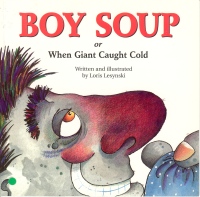
"I completed Boy Soup after about a hundred and seven rewrites, but Scholastic was unresponsive, so I thought, 'Who would be the right publisher for this?' I sent it to Annick Press. Rick Wilks called me almost right away, and they picked it up for the very next list! I had to 'audition' to do the illustrations, though, because I'd never done a picture book before, and I plunged immediately into them over a winter I remember nothing else about. This was the beginning of a very good relationship between me and Annick, and I've developed as a writer in ways I don't believe I could have done with any other publisher. The letter of acceptance from Rick Wilks about publishing my first book is practically worn through from all the times I've handled it and read it over, thrilled every time."
"I found book illustration to be quite complex - deciding what to draw is critical, as important as the artwork itself. You have a certain amount of text on any given page: what part of it are you going to illustrate - the beginning? The middle? The end? Maybe something that happened OFF the page? If you're asking children to look at a spread for even 30 seconds, what will you offer them in the illustration? How will their eyes move? How long before they lose interest in the picture? It's like making a little movie and then taking 30 stills from it."
"I think an essential element of a picture book is repeatability - a story involving a sequence of emotions and ideas that the reader wants to go through again another time. A book is an experience, and some of the not-so-good books out there are only a one-time experience at best. You read it, enjoy it, fine - it's over. Kids deserve better."
Loris had some specific intentions for her books. "I hoped to do books that worked on several levels - stories clear enough for four-year-olds to understand and enjoy from the pictures, with plots and aspects that even eleven-year-olds could get a kick out of. I also really wanted to write
rhyming verse where the 'performingness' was innate, where I had done the work necessary to indicate emphasis and intonation, loudness and softness, humour, exaggeration. Then whoever picked it up - a kid, an adult, a baby-sitter, a granddad - would become a good performer automatically, no rehearsal or drama degree required. The writing, itself, would turn the out-loud reader into an immediate performer. When I hear kids pick up Boy Soup cold to read aloud to their friends and they get the rhythm just right, I'm immensely pleased. This makes the stories and poems take a long time to write. If there's a sentence or a line where the reader might not be sure where to put the emphasis, it's changed. I don't want the reader to stumble; I want it to be as clear as can be before it goes out to people's radically different reading styles, phrasing, and regional pronunciation."
How did Boy Soup come to be? "The title just jumped into my head one day. I left what I was doing (vacuuming) and wrote it down immediately - I often start a poem or story with the title - then went on to scribble, 'The boys cooked the carrots, the boys boiled the peas,' which
is a line in the middle of the book. That's not unusual for me, to do things out of linear order. I love alliteration, like 'cooked carrots' and the 'boys boiled,' very chewy language. Boy Soup took a staggering number of hours to write because it was my first book, and I learned from it,
changing the ending and rewriting the middle until I had the right threads running through it." Asked if the text was finalized before the illustrations were done, Loris replies, "No, that makes me sound much more orderly than is true. Final changes to wording were being made days before
it went to press. Annick was great to work with that way, their respect for getting it right."
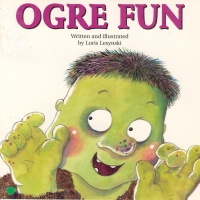
Ogre Fun originated in a laundromat. "I kept yawning, waiting for the rinse cycle to end. I thought, 'What if you couldn't stop yawning?' Then, 'Wait a minute. Ogres would be easier to
draw than people. What if the story was that OGRES couldn't stop yawning?' I took a piece of paper from the wastebasket and started writing. In the story, ogres 'catch' yawning from children, whom they've never seen before, can't stop, and it changes their ogre lives. I have still have
that piece of paper."
The idea for Catmagic had a more direct connection to Peter's class. "The whole class went to the one of the writer's houses, Jean, an older woman who had a patterned rug, patterned furniture, and a tortoiseshell cat. The cat practically disappeared in all the specks and roses and vines. On the spot, I started making notes for a story. Soon after - if you consider five years 'soon' - Catmagic came out. In Catmagic, Izzy, the blotchy, splotchy, multicoloured cat, goes to live in a witches' retirement home. Because he's so easily camouflaged, he gets tripped over, sat on and dented. He collects scraps of old magic spells which make it possible for him to live on the ceiling. It was a simple idea, with some twists and turns, and a lot of fun to draw because of all the furniture (furniture also being easier than people.)"
"Izzy in Catmagic is named after Ira Gershwin who wrote such great lyrics for Broadway (lyrics being, after all, rhyming verse). Izzy was his nickname. I also liked the wordplay of 'Izzy, where is he?'"
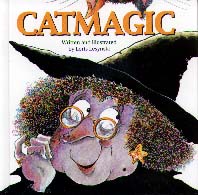
"After the first three rhyming storybooks, Annick and I worked out how we wanted to do the first book of poems. I had a huge number of poems in hand, and we had to decide what the narrative link was. I think that's what publishers want nowadays from a book of poetry, some kind of link or theme, not just a disconnected collection. The poems in Dirty Dog Boogie are all about a bouncing rhythm obviously being danced to by the dog on the cover. Recently I started taking a set of bongo drums with me on school visits, and kids learn how to tap out the poems in this book after one try."
Loris encourages kids to take the rhythms of any of her poems and use them for their own, with
any changes or variations they want. "It took me such a long time to get my poems published that by the time I did, it just wasn't about me me me any more. In fact, the more schoolkids I saw, the more I wanted to say to them, 'Do whatever you want with this stuff. It's not carved in stone.
It's not even really mine anymore. Write your own poems.' The back of the book says
or rearrange the beat.
Know a poem? Show it off
to everyone you meet!
That intention, that kids take these poems and make them their own, has really panned out. I'll go into a class, and a boy in grade five has on his dad's white jacket, he's formed a microphone out of tinfoil, and he has four girls behind him to doing the chorus while he does a Vegas variation of 'Can't Sit Still.' Six kids do 'Wet Feet: A Winter Chant' at their Christmas concert, writing several new stanzas. Kids write illustrated variations of 'If I Had a Brudda,' often in groups, with choreography and actions, sometimes in classroom contests. And the spin-offs from Nothing Beats A Pizza keep pouring in, too. It's great that they can use my books like that. My writing isn't something at a distance about which they're supposed to say, "Oh, isn't this grownup's
work admirable."
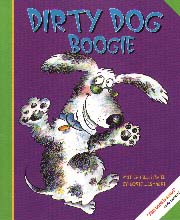
"On the first mock-up of Dirty Dog Boogie, at the bottom of the poem 'SOS (Send Only Sausages),' I put the line 'Boys and girls! Why don't you write an SOS poem too?' Then I went ACK, does that ever sound like a school book. So I decided to make any or all suggestions visually. 'SOS' is accompanied by illustrations of three kids with cartoon speech balloons, one saying 'Save Old Sandwiches, SOS!'; another, 'Sleeping Over Saturday, SOS!'; the third, 'Seven Orange Salamanders, SOS!' Another poem in the same collection is 'Housesong,' and I wanted to say, 'Try putting different words into existing poems,' and so I did that by rewriting it as 'Headsong' with its own illustration."
"I want to talk to kids as if we're an 'us,' like 'us writers,' or 'us readers,' rather than me-author and them-listeners."
Loris hauls a big portfolio case full of show-and-tell to school visits. "Early on, I decided to forego PowerPoint, slides and overheads because, when technology doesn't work, it puts such a damper on a presentation. You ask for a slide projector, you get an overhead; you ask for an overhead, you get a coffeemaker. I take in actual roughs, finished artwork, enlarged drawing and writing from my own childhood, scribbled notes, and it all works very well. If it's too big a
group to see a piece of cardboard held up, they can look at it afterwards."
"'See all these changes and erasures, scribbles, arrows, and notes?' I can say to older students when I show them actual art roughs, which usually look messy and quite awful. 'The same thing goes on in the writing - revising and editing the words, moving some, erasing others.' I ask them if they think this is sometimes hard (yes). If it means you have to be patient (yes). Do they think I do this to make the story more boring or more interesting? I really stress that the revising, editing, reworking and redrawing are all TO MAKE THE STORY OR PICTURE BETTER. Because this
was my own biggest obstacle, I assume it must also be true for some others. Sure, you want it to be perfect faster, whatever you're doing. Well, it's not going to happen that way, not for anybody. Nowadays I really love the revising and refining stages of the work, but it took me a
long time to learn to tolerate it. While you're doing a rough, what you're feeling is uncertainty. You don't know if it's going to turn out. You don't know if it's going to be any good. You're uneasy. Part of learning the craft is being able to stand that uneasiness."
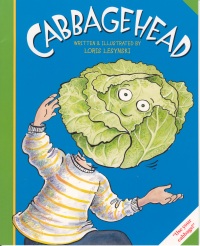
"That's kind of what Cabbagehead was about, getting your best ideas even when you're feeling
stupid or blank. There's a spread where I've done a lot of cabbage variations - a cabbage hot air balloon, cabbage yo-yo, cabbage planet earth - and I ask kids, 'What else could we have come up with?' This leads to great discussions. I like creative playing like this because there's no wrong
answer."
"There's not a lot of hidden meaning in my stuff (although there is a little). If my elbow goes through the sleeve of my pajamas, I write a poem that day about pajamas. If I recall my cheap plastic winter boots leaking when I walked home from school, I write 'How can anyone be happy
when they've got wet feet?' I'm not a teacher, or a parent, and I think being neither allows me to come at the world with a 10-year-old point of view. What does my inner 10-year-old care about? wonder about? want to know?"
"I have to admit that the 'famous' part of being an author is quite appealing. When I go to a school, the kids throng me at the door. I really enjoy talking to kids and love to encourage creativity. Granted, I see children under the best possible circumstances: they're clean and dry,
they're sitting nicely in rows, they're quite polite to me while their teachers are watching, and when we're tired of each other, we're allowed to part."
"I'm constantly on the lookout for how to finetune school visits. I used to say that you've got 30 seconds to establish rapport with a new crowd of children, I now realize you don't have 30, you've got maybe 3! In the movie Pirates of the Caribbean, from the very second Johnny Depp comes on the screen - before he says a word, before he does anything at all - he's emanating what he is. That clarified for me what I'd been coming to understand, that when you walk into a room full of children you don't know, before you say anything, before you do anything, right from the
center of yourself you need to emanate that you're really glad to be there, and like them, and intend to say things for them, things worth listening to. They can sense all that. The response I get back is usually terrific, even from shy kids or the jumpier ones. (If there's a particularly obstreperous little boy who shouts out the opposite of whatever the other kids say, I tell him if he keeps that up then, after the reading, I'm going to hug him and kiss him a lot.)"
"Kids love doing the poetry out loud. We really ham it up. It's enormous fun, although I never
take it into frenzy or shrieking. I can't stand it when children's performers use yelling."
"I hope the children come away thinking, 'Wait a minute. If she's a real person, then the other people who did the books are real people, and maybe I could try it too.'"

To write Zigzag: Zoems for Zindergarten, Loris visited JK and SK classrooms. "Boy, was that a learning experience. At first I thought the kindies were a bit like lunatics. They'd laugh out of the blue and cry all of a sudden. Some spoke in foreign tongues, some said nothing, some chatted non-stop as I (allegedly) did at the same age. Also they were so small and moved quite erratically. Then I began to get them and to understand kindergarten culture. It's quite different from even grade one. Kindergarten is an incredible stage of humanity. I don't believe there's any way we can
overspend on preschool and kindergarten. That's where the roots of our school experience begin."
"I wanted Zigzag to be a book that a child would like even if he or she didn't speak English or had never heard a poem before. I wanted the sounds themselves and the flow of them to be
appealing, separate from the meanings of the words."
"The main thing that I did while writing Zigzag, other than visit kindergartens, was to throw
words out. I must have written 20 to 30 times as many words as I left in. You don't overload poems for five-year-olds, you just don't."
"Actually, one of hardest things to learn about creativity is that it isn't just about creating. It's create-AND-destroy, select-AND-reject, keep-AND-throw away. It's that throwing away part, the erasing, the scrapping, that's so hard - we start off thinking every word we wrote is precious. Not so!"
Asked how she knows when a poem is 'done,' Loris responds, "Oh, you absolutely know. A poem clicks into place; it's very clear when it's enough. And it's ironic that sometimes the lightest, fluffiest poems have taken the longest time and most work to finish."
Loris would like to write more poetry for the very young. "Poems for three-to-five-year-olds really matter, and many of the books that say 'Poems for Young People' have poems both too old
(too much irony and plot) and too young (baby fingerplays) for kindergarten. I added the subtitle Zoems for Zindergarten to Zigzag to let parents and teachers know that every poem was preselected, tested and right for kindergarten. I'm working on a book of poems for even younger
kids, nursery school age. Quite a challenge. It'll probably have hardly any words in it."
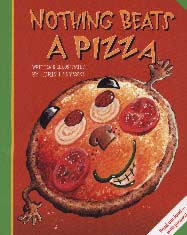
Nothing Beats A Pizza was a Mr. Christie's award honour book. "I really enjoyed writing this book. The poem 'Too Many Amandas' came about, simply enough, because one of the classes I visited had so many Amandas in it. I love the melody of those words together, 'Too Many Amandas' - that title just fell into place. Every now and then writing is easy." Loris's freedom to design her books allows her to twist and turn some poems; in this book, 'How Sam Eats' is sideways. "With classes, I do 'Pizza Theme & Variations,' using Goldilocks ('porridge too hot? porridge too cold? the story of Goldilocks could be told - with pizza!') You can say to kids, 'Try it with other fairy tales,' and so, for instance, we've done Hansel and Gretel with the witch's cottage made out of pizza. 'The Bad Mood Blues' is a great performance piece with kids. I ask, 'Is there anybody in this room who ever wakes up feeling a bit crabby?' (Almost all hands.) They really like doing that poem. I ask them to sound very jazzy, very sharp, all on cue."
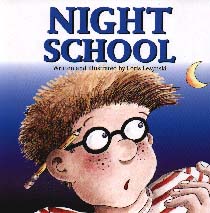
"The fourth storybook, Night School, was especially interesting to do. I learned about nocturnal animals, about bioluminescence. I used an animal called the Slow Loris on the nighttime
animals page." While Loris was doing that book, a brand new product was invented: gel pens. "Title pages are usually in white or a very pale colour, so the author can sign the book; suddenly I was able to do a dark title page, knowing I could inscribe it with a white gel pen!"
"I did a lot of Night School using a magnifying drawing lamp to do the tiny raccoons on the title page, the book titles in other illustrations. I kept it on for so many hours that the plastic casing melted. Very Salvador Dali."
Rocksy, the fifth storybook, is about a girl who turns to stone. "It was interesting to think, 'What would you do if you knew you couldn't get hurt? What would food taste like if your tongue was made of rock? What would it feel like to stroke your cat with boulder hands?'"
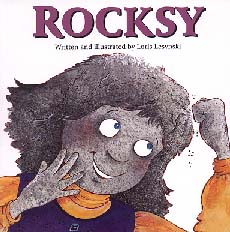
Originally, Rocksy was a modern-day story, and then Loris decided to give it a mock-medieval twist, indicated by the clothing. "When you do a picture book, it's you the illustrator who has to decide what the characters will wear. This also used to happen in educational illustration. Once for a French book, I had to draw a carrot character dressed up in a Halloween costume. Well, now, how'm I gonna do that? I wondered. I mean, the minute you put the carrot into a costume, you hide the fact that it's... a carrot. Finally I put him into black mask just over the eyes (or where I assumed the carroteyes would be) and a t-shirt with a skeleton on it. Ta-da, a costume! Then black-and-white saddle shoes just seemed the obvious footwear. Whew! And everyone thinks this job is a piece of cake."
Many of Loris's poems contain autobiographical elements. For instance, in Cabbagehead, there's 'Go Away, Poem' which is about how a verse can strike in the middle of the night,
demanding to be written when all you want to do is sleeeeeep. Explains Loris, "A lively imagination is a gift but also a nuisance. When you're trying to concentrate on something, it's always saying excitedly, 'Oh, why don't you try this? Why don't you try that?' It can be quite annoying sometimes when you get an idea just before you are going off to sleep. That's not when you want it! But if you don't write it down, it disappears, probably gone for good."
Another poem in that book which is very autobiographical is 'A Have-to-do about Fighting,' about arguing parents. "If I can get that middle-reader novel going, I'd have to say something - well, lots - about our intrepid heroine who deals with the parents arguing all the time. I guess this would mean going through some painful memories, putting myself back into that experience, and the way a kid feels so suffocated by that atmosphere."
Loris is always having fun with her books and her readers. Adults who are familiar with the 'puffs,' the positive quotes from other authors that often appear on book covers, may have seen the 'This book is a riot!' endorsement on Dirty Dog Boogie, but did they notice its source - Loris Lesynski? The copyright page also falls victim to Loris's offbeat sense of humour. "Most picture books have a little blurb where the artist tells you what art materials they used. It's
in six point type, and nobody really reads that copyright page, so I thought I'd play with it." Consequently, in addition to colored pencil and watercolor, Loris ostensibly employed "house paint, tomato sauce, eyeshadow, [and] rubber stamp-pad ink" in rendering the illustrations for
Nothing Beats A Pizza. (You can look up the weird art supplies used in Cabbagehead yourself.)"
While it's not uncommon for authors to dedicate their books to someone, Loris adds another dimension - a photo of the person to whom the book is dedicated. About this feature, Loris smilingly asserts, "I've run out of loved ones, and I always need to earn a little more money - maybe I should sell that space? 'For a small fee, you, too, can have a book dedicated to you.'" Loris also often uses her friends' dogs and cats in illustrations that go with the poems. Maybe she could run a sideline business, putting people's pets in her books?"
Asked what's coming next, Loris replies, "Well, there's this novel we were having that imaginary conversation about. And definitely a book of poems for toddlers, and I'm also working on a book of reflections and thoughts about the wonders of numbers and mathematics, in poem form. Annick is publishing a collection of those of my poems that kids have liked best, with Michael
Martchenko illustrating them, and we're going to put in some very interesting sidebars and visual explanations of how poems and other creative writing come to be. I have all kinds of other projects simmering on the back burner of my mind, too, including many poems that are in various stages of finishedness. My work is pretty much my life. Which is fine, though I did think this career would be more tra-la-la - you know, cups of tea, sunny mornings, birds chirping, drawing pictures, easy-does-it. It's not like that at all. Ideas need to be wrestled with, weeded, argued over, dug up. When they're not working, it feels horrible. Getting a book done, however, is a great experience."
"Then there's the whole issue of getting it published, then sold, then read - a book on a shelf means it's been purchased, but doesn't mean much else unless it is liked and used. All those books we see in the library are by definition not in people's hands at that moment. Not being read. If I go a school and see my book on the shelf, I feel fabulous. But if I came in the next day or a week later and my book was still there on the exact same shelf, clean and shiny, untouched, unmoved, how would I feel then? If it's not being read, what does a book amount to?"
"I used to think that literacy just meant the ability to read, but now I understand that literacy is a loop. I read something; it changes my understanding; I talk to you about it; you respond back to me; we both have something new to think about; we can compare it to other things; we have common ground. To reach that entry point into a kid's heart and mind is an incredible process. Marketing departments might think they can analyze and predict that, but they can't, and that's what makes books an art form."
Loris has learned from many educators and strongly believes herself that out-loud reading to children is extremely valuable. "I think that to enjoy reading, you need to fall in love with, to become engaged with, the rhythm of language, so that you have it inside yourself, you're familiar with story cadence. Conversation isn't enough. Aside from writing and drawing, this is something I really like, exploring and encouraging the rhythm of language, the love of language. It's very interesting to speak at a Family Reading Night at a school with a large immigrant population in the parents and to notice that they enjoy it, too. It's an excellent thing that retired people can do if they wish to donate their time: out-loud reading at community centres, shelters, libraries."
Lately, she says, she's also been thinking that "when you have readers, you have ethics. They go together. When people read, they imagine themselves in other peoples' shoes. Wouldn't that
improve compassion and tolerance?"
Loris says that the thing she likes best "is when my work is going well and I'm utterly engrossed in it. The thing I like second best is when I'm told that the kids were chanting the poems in the playground the day after I was there. Then I know that I've found that entry point."
"This career can be somewhat isolating. I'm lucky to have many friends and colleagues, but I do work alone, which means I work at odd times of day, sometimes work too much, sometimes too little, almost always too messy. Sometimes I go round and round in circles and just can't stop. I wanted be a children's writer from the time I was in grade three, and I didn't do it until I was 46. That's major going-around-in-circles! I did lots of interesting and wonderful things in that time, but I didn't do what I'd intended to do. I needed some prodding and advice. Maybe I can offer that to kids, some feedback from my own experience."
"I forgot to tell you about playing the cello ... and liking the poetry of e. e. cummings ... and basically about three decades in there, but one interview can't cover everything!"
"One more thing, though, that I wanted to say - writing is a wonderful thing to do, to get better at, completely separate from getting published. Write out your memories of childhood experiences (with a rewrite, so it goes into a good story voice). Jot down the story outlines you come up with. Scribble a scrap of rhythm or rhyme and add to it later. Do you have a friend who says brilliantly droll things? Do you have off-the-wall reflections? Do you have ideas for inventions or adventures? Write them down."
Books illustrated by Loris Lesynski
Short stories written by Loris Lesynski
This article is based on an interview conducted in Toronto on February 26, 2005, and revised by Loris Lesynski in November, 2005.
Visit Loris's website at www.lorislesynski.com
